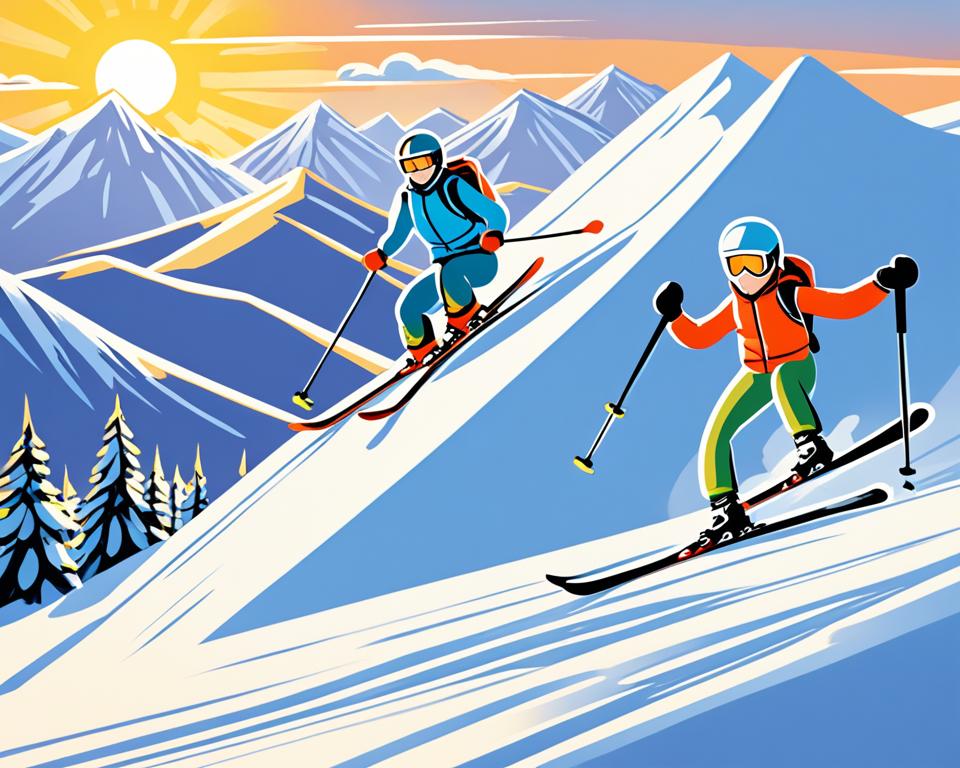When it comes to skiing, the choice between long skis and short skis is a topic of much debate. Both options offer unique advantages and it’s important to understand the differences in order to make an informed decision. In this article, we will compare long skis and short skis, look at the factors that influence ski length selection, and provide a guide to help you choose the perfect skis for your needs.
So, whether you’re a beginner looking to master the slopes or an experienced skier aiming for high-speed adventures, read on to discover the key differences and considerations when it comes to ski length.
Key Takeaways:
- Long skis and short skis have distinct characteristics that cater to different skiing styles and abilities.
- Short skis, typically under 160 cm, are known for their maneuverability and are ideal for beginners, terrain parks, and moguls.
- Long skis, typically over 170 cm, offer stability and speed, making them suitable for advanced skiers and ungroomed terrain.
- Choosing the right ski length depends on factors such as skiing style, ability, terrain preference, stability, and maneuverability.
- Consulting with ski experts or instructors and trying out different lengths can help determine the best choice for your specific needs.
Now that we’ve introduced the topic and provided a sneak peek into the key takeaways, let’s delve deeper into the advantages of shorter skis and why they may be the preferred choice for some skiers.
Advantages of Shorter Skis
Shorter skis offer several advantages that make them a popular choice for skiers of all levels. Whether you’re a beginner or an experienced skier, opting for shorter skis can enhance your skiing experience in multiple ways.
1. Maneuverability
One of the key advantages of shorter skis is their superior maneuverability. Due to their reduced length, they are easier to turn and control, especially in tight spaces such as moguls or trees. The shorter length allows for quicker and more responsive movements, enabling skiers to navigate challenging terrains with ease.
2. Easier Learning
Short skis are particularly beneficial for beginners. Their forgiving and responsive nature makes them easier to handle, requiring less effort to initiate turns. This enhanced responsiveness helps boost confidence and enables beginners to progress quickly in their skiing skills. With shorter skis, the learning curve becomes more manageable, making skiing a more enjoyable experience.
3. Playfulness
Short skis provide a playful and dynamic skiing experience. The reduced length allows for quicker edge-to-edge transitions, making them ideal for freestyle skiing or activities in terrain parks. The playful nature of shorter skis adds an element of excitement and fun to your skiing adventures, keeping you engaged and entertained on the slopes.
Contrary to popular belief, skiing with shorter skis is not a disadvantage, but rather a benefit for a wide range of skiers. The maneuverability, easier learning curve, and playfulness offered by shorter skis make them an excellent choice for skiers who value agility, responsiveness, and an enjoyable skiing experience.
Stay tuned for the next section, where we will explore the advantages of longer skis and help you make an informed decision when choosing your ski length.
Advantages of Longer Skis
While shorter skis have their advantages, longer skis also offer unique benefits. Longer skis provide stability at high speeds, allowing skiers to maintain control and ski more aggressively. They also offer better edge grip on hard snow, making them ideal for carving turns on groomed runs.
However, it’s important to note that longer skis may feel clunky and heavy for most skiers, especially in terrain parks or on slopes where maneuverability is key. Unless you are an advanced skier who enjoys challenging terrain, longer skis may not be necessary for optimal performance.
While longer skis provide stability and better edge grip, they may not be suitable for all skiers. The decision to use longer skis should be based on your skiing style, skill level, and the specific terrain you will be skiing on. It is recommended to try out different ski lengths and consult with experts to determine the best option for your needs.
Considerations for Choosing Ski Length
When it comes to choosing the right length for your skis, it’s essential to consider various factors that can impact your skiing experience. Your skiing style, ability, terrain preference, stability, and maneuverability should all play a role in determining the ideal ski length for you.
If you’re someone who enjoys a playful, freestyle skiing style or if you’re a beginner, opting for shorter skis may be the best decision. Shorter skis offer greater maneuverability and ease of control, allowing you to navigate the slopes more effortlessly. They can enhance your learning curve and maximize your enjoyment on the mountain.
On the other hand, if you’re an advanced skier who craves speed and stability, longer skis might be better suited to your needs. Longer skis provide enhanced stability at higher speeds, making them ideal for those who love to push their limits on the slopes. Additionally, longer skis offer improved edge grip, particularly on hard snow, allowing for precise carving turns on groomed runs.
It’s crucial to consider your terrain preference when choosing ski length as well. If you predominantly ski on groomed runs or enjoy tackling steep, ungroomed terrain, longer skis can provide the necessary edge grip and stability for such conditions. However, if you often find yourself in tight spaces like moguls or trees, shorter skis’ increased maneuverability may be a more suitable choice.
Ultimately, the right ski length for you is a combination of personal preference, skiing style and ability, and the specific conditions you will be skiing in. Take these factors into account, and consider seeking advice from ski experts or instructors who can offer further guidance based on your unique requirements. By choosing the correct ski length, you can elevate your skiing performance and make the most of your time on the slopes.
Conclusion
Choosing between long skis and short skis is a personal decision that depends on your skiing style and preferences. Both ski lengths have their own advantages and disadvantages, so it’s important to consider factors such as maneuverability, stability, speed, and terrain preference when making your choice.
For skiers looking for more maneuverability, ease of learning, and playfulness, shorter skis are recommended. They offer greater control and responsiveness, making them ideal for beginners and those who enjoy freestyle skiing activities. On the other hand, if you’re an advanced skier who values stability, speed, and better edge grip on hard snow, longer skis may be more suitable.
To make an informed decision, it’s advisable to try out different ski lengths and seek advice from ski experts or instructors. They can provide valuable recommendations based on your skill level and the specific conditions you’ll be skiing in. Remember, selecting the right ski length can greatly enhance your skiing performance and overall enjoyment on the slopes.
FAQ
What are the advantages of shorter skis?
Shorter skis are more maneuverable, making them easier to turn and control, especially in tight spaces like moguls or trees. They are also recommended for beginners as they are more forgiving and responsive, requiring less effort to initiate turns. Short skis offer quicker edge-to-edge transitions, making them fun for freestyle skiing or terrain park activities.
What are the advantages of longer skis?
Longer skis provide stability at high speeds, allowing skiers to maintain control and ski more aggressively. They also offer better edge grip on hard snow, making them ideal for carving turns on groomed runs. However, longer skis may feel clunky and heavy for most skiers, especially in terrain parks or on slopes where maneuverability is key.
What factors should I consider when choosing ski length?
When choosing ski length, consider your skiing style, ability, and terrain preference. If you prefer a more playful, freestyle skiing style or are a beginner, shorter skis may be the better choice. On the other hand, if you are an advanced skier who enjoys speed and stability, longer skis may be more suitable. Terrain preference, such as groomed runs or steep, ungroomed terrain, may also factor into your decision.
Should I choose long or short skis?
The choice between long skis and short skis ultimately depends on personal preference and skiing style. Both lengths have their advantages and disadvantages. Shorter skis offer more maneuverability, ease of learning, and playfulness, while longer skis provide stability, speed, and better edge grip. It’s recommended to try out different lengths and consult with ski experts or instructors to determine the best length for your specific needs.
What are some ski length recommendations?
Ski length recommendations depend on a combination of factors such as personal preference, skiing style, ability, and terrain conditions. For beginners or those who prefer a playful skiing style, shorter skis are generally recommended. For advanced skiers or those who prioritize speed and stability, longer skis may be more suitable. It’s important to try out different lengths and consider the specific conditions you will be skiing in to find the best fit for you.


![Ray Dalio Quotes [Principles, Life, Investment]](https://tagvault.org/wp-content/uploads/2023/04/Screen-Shot-2023-04-19-at-7.57.49-PM.png)